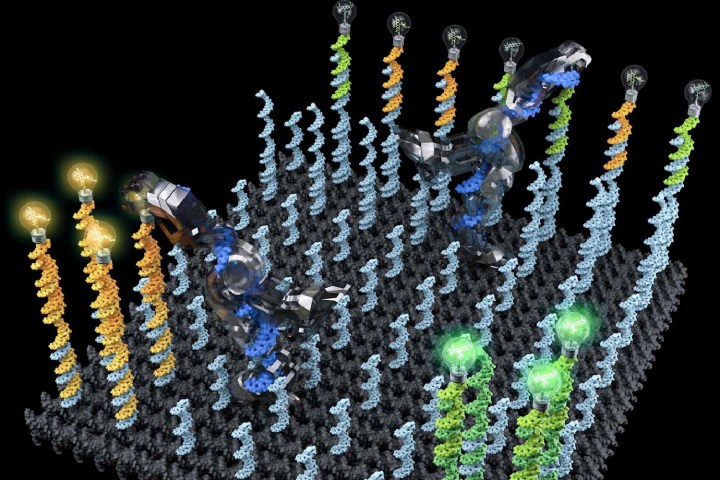
Well, imagine no more because that is whatCalifornia Institute of Technology scientists have created with a new DNA-based “robot” that may one day be performing “cargo sorting” jobs in places like our bloodstream. While it is not yet being used to do so, during a proof of concept, the robot was able to pick up scattered molecules — either from a fluorescent yellow dye or fluorescent pink dye — and sorting them into their correct location. Adding more robots to work alongside it, shortened the time it took to complete the job.
“We demonstrated that a single robot sorted six cargoes of two types in roughly 10 hours, and four to five robots on the surface completed the same task in about one hour,” Lulu Qian, assistant professor of bioengineering, told Digital Trends. “We also demonstrated that two different sorting tasks could simultaneously take place on two surfaces in the same test tube, which shows the possibility of different ‘teams’ of DNA robots working on different tasks in parallel.”
While they are far too small to see without extreme magnification, the robots do look broadly humanoid in structure — with two feet for walking and an arm and hand for picking up their cargo.
The robots are not the only nanoscale creations being developed in labs. Other similar projects have developed everything from tiny cars 100 times smaller than a DNA molecule to similarly sized tools like wrenches, which can be used for adjusted the shape of other molecules.
As fast-moving as the research is in this area, however, Qian explained that it will be some time before we’re injecting Fantastic Voyage-style robots into our bodies to carry out tasks. “These DNA robots are not good for practical uses yet,” Qian said. “We focused on understanding the engineering principles for building complex robotics systems in an ideal test tube environment. There is a long way to go for transferring the understanding to the development of DNA robots that could actually be used for applications in chemical synthesis, therapeutics, and materials.”
A paper describing the research is published in the Friday, September 15 issue of the journal Science.


